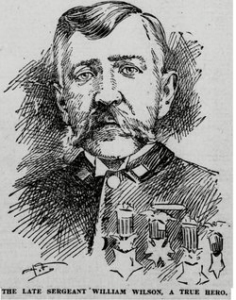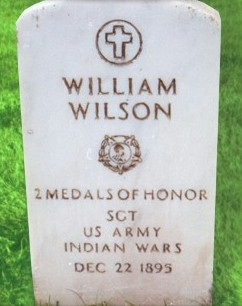b. 17/06/1944 Philadelphia, Pennsylvania. d. 22/12/1895 San Francisco, California.
DATE OF MOH ACTIONS: 28/03/1872 Colorado Valley, Texas and 29/09/1872 Red River, Texas
Born in Philadelphia, Pennsylvania in 1847, William Wilson left the Keystone State as a young man to join the military. Mustering in with the U.S. Cavalry in October 1865, he subsequently participated in “all the Indian campaigns through Texas and the Sioux War of 1876.”
During the early 1870s, Wilson was initially stationed at Fort Sill, in Indian Territory (in what is now Oklahoma), and then at Fort Concho, a remote outpost in Texas near what is today, San Angelo, the latter of which was so small that it was staffed by less than two dozen horse soldiers. When Wilson and his fellow soldiers received word in March 1872 that a group of Comanche had stolen cattle during a raid on a farm near Fort Concho, he ordered a corporal and 20 privates to join him in responding. Catching up with the raiders near the Colorado River the next morning, after having ridden all night, he and his men killed four of the raiding party and captured a Mexican teenager who was traveling with them. After obtaining information from the boy regarding the raiders’ activities and location, Wilson and his men were able to uncover a ring of Comancheros and New Mexico-based smugglers who had been supplying members of the Comanche tribe who were deemed hostile to the U.S. Government. With the U.S. Army’s resulting success in resolving the situation at Colorado Valley, Texas on March 28, 1872, Sgt. Wilson was awarded his first U.S. Medal of Honor on April 27, 1872.
Wilson then earned his second Medal of Honor six months later. Part of a larger U.S. Cavalry force led through Texas by Gen. Ranald S. Mackenzie, Wilson and his fellow soldiers came upon a very large Commanche settlement along the North Fork of the Red River. One village alone was reported to have been made up of between 260 and 280 lodges with as many as 500 male and 300 female inhabitants. At 4 p.m. on September 28, 1872, the U.S. cavalrymen charged, beginning the Battle of the North Fork of the Red River, but were initially repulsed by one of the villages. When Mackenzie realized that the initial engagement had rendered Wilson’s immediate superior incapable of continuing, Mackenzie ordered Wilson to take charge of his unit and attack a second village. Fighting in and around that village until sunset, Wilson and his men killed more than 100 members of the tribe, burned the village, and seized 3,000 ponies plus the village’s food and other supplies. Also taking 130 surviving tribe members captive (most of whom were women and children), Mackenzie and his men held them as prisoners at Fort Concho through the winter.
The day after the attack (September 29, 1872), Wilson was awarded his second Medal of Honor for “distinguished conduct in action with Indians at Red River, Texas.” He was also recognized by the U.S. Army later that fall via General Orders:
Sometime during the late 1870s, Wilson took a brief break from military life to return to Philadelphia, where he worked as a railway superintendent, but after five years, he returned to active military duty, officially resuming his service in 1882. A sergeant with the U.S. 4th Cavalry’s B Troop during the early 1890s, Wilson filed reports documenting his summer 1894 supervision of national park land patrols. On July 22, 1894, he wrote to the acting superintendent of Sequoia National Park:
Diagnosed with stomach cancer in November 1895, Wilson’s health quickly declined. Six weeks later, after shaking hands with each member of his cavalry unit on Sunday, December 22, 1895, he died at 12:30 p.m. that afternoon at the age of 48. A member of the Grand Army of the Republic, he had also been a member of the Army and Navy Union and of the Medal of Honor Legion, and had had only one year to serve until becoming eligible for retirement at three-quarters pay.
His funeral was held on the morning of Christmas Eve, Tuesday, December 24, 1895. Following services which began at 10:30 a.m. at the Presidio’s Post Hospital,[23] he was buried with military honors at San Francisco National Cemetery (Section WS, Site 527).
MOH CITATION:
First Award: In pursuit of a band of cattle thieves from New Mexico.
Second Award: Distinguished conduct in action with Indians.
BURIAL LOCATION: SAN FRANCISCO NATIONAL CEMETERY, SAN FRANCISCO, CALIFORNIA.
SECTION WS, GRAVE 527, ROW 28.
LOCATION OF MEDALS: UNKNOWN.

